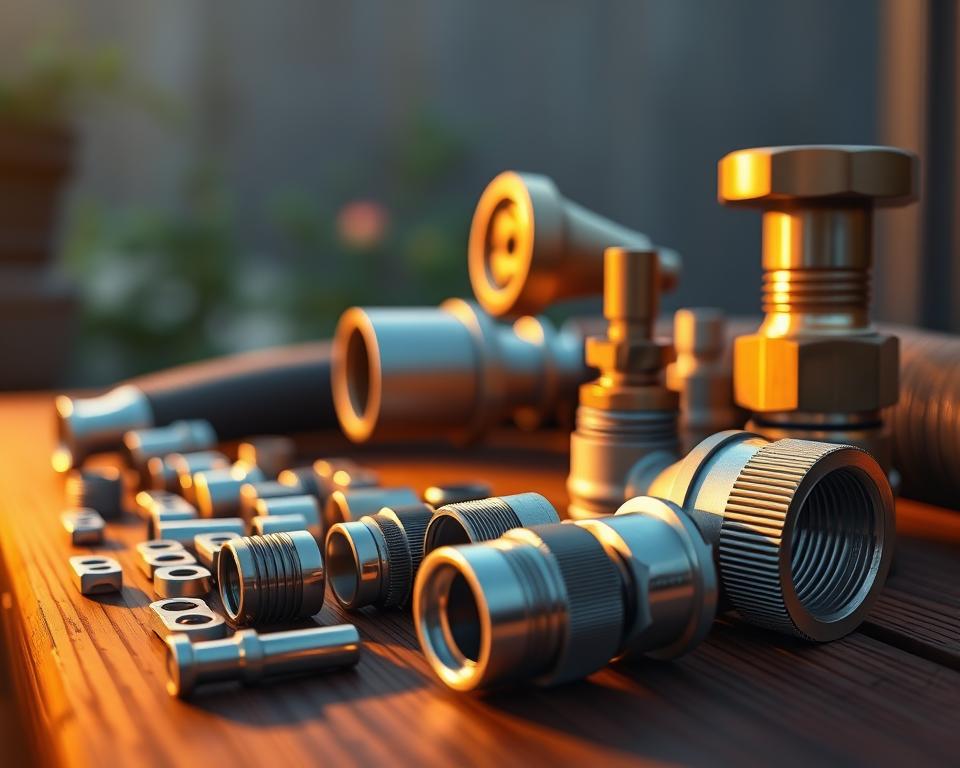Yard Must-Haves: Standard Garden Hose Fittings
Ever wondered why your watering system leaks or underperforms? Tiny garden hose size fitting connectors—your standard garden hose fittings—often cause leaks and poor performance. They preserve flow, guard against leaks, and support a healthy yard.
Installation Parts Supply, a trusted provider of plumbing solutions, highlights that 67% of hose failures stem from poor-quality or mismatched connectors. The correct connectors matter for everything from a basic hose to a full irrigation system.
With ANSI ¾”-11.5 NH threads, most fittings fit most hoses. Use this guide to pick sturdy materials, verify PSI ratings, and sidestep mistakes. Improve your system worry-free!
Notable Observations
- Right fittings eliminate leaks and conserve water.
- 3/4″ ANSI ¾”-11.5 NH is the go-to thread spec.
- Installation Parts Supply provides dependable hose components.
- Durability hinges on chosen materials and pressure ratings.
- Two-thirds of hose failures start at faulty connections.

Choosing the Correct Fittings: Why It Matters
Did you know leaky connections waste more water than you think? Inferior connectors cause 40% of irrigation water waste. That’s water flowing away as if you’d left a faucet wide open!
Improper connectors cut water pressure by 15–20%. Your spray may fall short of the grass. Limit pressure-washer hoses to 50 ft to avoid flow loss.
Don’t overlook safety issues. Burst connections at high PSI can injure users or damage equipment. Their pressure-tested connectors resist bursts and keep you safe.
Longevity is crucial. Rustproof metals outlive cheap plastics in coastal or humid areas. Quick-connect fittings often crack in frost—check them each season.
A user reported a 35% increase in sprinkler coverage after switching fittings. Proper fittings cut waste, work faster, and lower bills—no guesswork.
What Makes a Garden Hose Fitting
How come some connectors stand the test of time and others don’t? It comes down to parts like ferrules, seals, and threads. Every component contributes to leak prevention and flow.
Ribbed collars hold hoses firmly in place. Smooth collars fit well on high-pressure hoses. Barbed collars grip strongly but may impede flow if misaligned.
Flat washers keep your fittings leak-free. Loose or old washers lead to leaks. Seat the washer fully before you tighten to avoid drips.
Thread depth affects sealing. Fully engage the threads to avoid leaks. Gaps invite leaks. Single-body couplings hold up better under tough conditions than multi-part ones.
Their anti-kink feature guards against kinks and wear. It prevents sharp bends that cause leaks. Rotate O-ring inspections every three months to preserve sealing.
Built-to-last connectors save you time and money. Match the size and design to your needs, and you’ll avoid common pitfalls.
Types of Garden Hose Fittings: Which One Do You Need?
Confused by the dizzying array of connection options? We’ll break it down. Different fittings fill different needs—from speed to pressure control.
Snap-on disconnects speed tool changes. Plastic fits lighter jobs; brass suits heavy-duty pressure. Frost-resistant valves stand up to subzero conditions.
Swivel connectors let your hose pivot 270° to avoid kinks. Use Y-splitters to feed two hoses at once. Great for washing cars while watering plants.
Pressure-regulating adapters protect sprinklers from surges. They stabilize flow when upstream PSI jumps. See the chart for price and flow comparisons:
| Type | Material | Cost | Flow Rate (GPM) |
|---|---|---|---|
| Quick-Connect | Plastic | $1.50 | 4.2 |
| Quick-Connect | Brass | $8.00 | 5.1 |
| Y-Splitter | Aluminum | $6.50 | 3.8 (per outlet) |
Camlock couplers give tight seals in demanding applications. Stainless builds stand up to harsh chemicals and fertilizers. Stick to ¾” threads for home hoses.
Pro tip: Keep spare washers for each fitting type. Old washers may cost you 20% of your pressure unnoticed.
Brass vs. Plastic vs. Aluminum
Not all connectors are created equal—material choice impacts durability and safety. Plastic fittings max out around 150 PSI; brass goes up to 500 PSI. Prop 65–compliant lead-free brass safeguards drinking water.
Aluminum outlasts plastic in sun exposure. Metal handles extreme temps (-20°F to 180°F), but plastic cracks in freezing weather. Their brass-aluminum combo fittings blend strength and lightness.
When choose plastic? Drip irrigation and short-term use. Compare plastic, brass, and hybrid in the chart:
| Type | Material | Cost | Max PSI |
|---|---|---|---|
| Coupler | Plastic | $4 | 150 |
| Coupler | Brass | $12 | 500 |
| Hybrid | Brass-Aluminum | $9 | 400 |
Select materials based on weather and pressure requirements. A single brass coupling beats plastic versions threefold in lifespan.
Garden Hose Sizing Guide: 3/4 Inch and Beyond
Your hose size determines GPM and spray distance. A ¾-inch hose delivers 5 GPM—enough for most sprinklers. 5/8″ hoses cap out at 3 GPM for soft watering.
Every extra foot saps pressure. Plan for a 1 PSI loss per linear foot. Pressure washers work best on hoses no longer than 50 ft. Use their adapters to join different diameters leak-free.
How length affects sprinklers:
- 25 ft: Perfect for small patios or container gardens.
- Reaches lawns up to 1,500 sq ft.
- 100 ft: Requires higher pressure to reach edges evenly.
Farms and big landscapes favor 1″ hoses. Farms and large landscapes benefit from their extra capacity. Refer to the table below:
| Diameter | Flow Rate (GPM) | Best For |
|---|---|---|
| ⅝ inch | 3 | Drip irrigation, small gardens |
| ¾ inch | 5 | Sprinklers, car washing |
| 1 inch | 7+ | Agriculture, large properties |
Determine your PSI and coverage needs. 3/4″ diameter is standard—just mind the hose length. Have adapters ready for quick tool changes.
Understanding PSI & Compatibility
Why do fittings give way when PSI jumps? The answer lies in PSI ratings. A 150 PSI connector might handle daily use, but spikes during valve closure can exceed 300 PSI—enough to burst weak parts.
Working PSI is different from burst PSI. A 300 PSI rating means the part withstands surges, not constant flow. Use their high-PSI parts to withstand surges in heavy applications.
Sun-warmed hoses increase PSI. Water heating in sun-exposed lines increases pressure by 5–10 PSI per 10°F. Add loops to let hoses expand safely.
Key Pressure Ratings Compared
| Rating | Best For | Burst Strength |
|---|---|---|
| 150 PSI | Residential sprinklers | 450 PSI |
| 300 PSI | Irrigation systems | 900 PSI |
| 600 PSI | Industrial use | 1,800 PSI |
Thread mismatches cause 30% of leaks. Adapters must meet your PSI requirements. A farm upgraded to 300 PSI brass fittings and cut water waste by 40%.
Mixing Old and New? Follow This Checklist
- Ensure threads match (ANSI ¾”-11.5 NH).
- Inspect washers for cracks before reusing.
- Test pressure tolerance of older parts.
- Replace corroded or dented connectors.
Your hose style and tools set your PSI requirements. Proper prep avoids expensive leaks.
Installation & Care Tips
Regular attention keeps leaks at bay. Start with an annual inspection—check for cracks, rust, or loose *components*. Secure any loose components right away.
Leak checks take minutes. Attach your setup to a *faucet*, turn on the water, and look for drips. Begin at each coupling. Their gauge makes hidden leaks obvious.
Winter prep prevents freeze damage. Empty hoses and stow inside. Cover outdoor faucets with insulation. It keeps frost from harming your setup.
Their installation toolkit includes:
- Adjustable wrench for firm connections
- Plumber’s tape to seal threads
- A washer replacement guide for DIY fixes
Swap washers biannually. Use correct-size washers—wrong ones cause 30% of leaks. Keep extras handy to *get job done* fast.
Store hoses coiled in shade. Direct sun breaks down hose compounds. Use a rack or reel for neat, ready hoses.
Can’t stop a drip? Do this:
- Brush threads clean of grit
- Apply plumber’s grease to stiff O-rings
- Replace damaged washers right away
Conclusion: Nail the Right Hose Fittings
Perfect fittings are the foundation of an upgraded watering rig. Brass or aluminum? Quick-connect or swivel? Match materials and types to your needs for leak-free performance.
Investing in good fittings is worth it. Brass fittings often pay for themselves in longevity. Installation Parts Supply backs its parts with warranties—peace of mind included.
Refer to this guide:
- Check pressure ratings before buying
- Inspect washers every season
- Store indoors during freezing temps
New smart fittings with leak detectors are coming soon. Meanwhile, ask the pros to get job done properly. Your garden hose system deserves the best!

